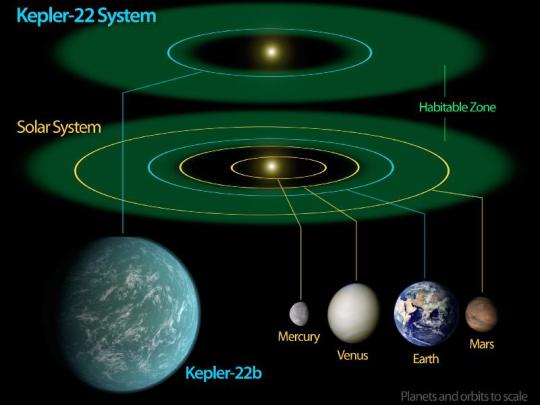Goldilocks Planet - The first "habitable zone" planet discovered - NASA's Kepler mission
It's a great gift," "We consider this sort of our Christmas planet." said William Borucki the father of the Kepler Spacecraft. To aspiring principle investigators, Borucki’s advice is to come up with science compelling enough to win long-term support from the science community. on Monday, Dec. 5, 2011. The team announced the confirmation of Kepler-22b, its first planet found in the "habitable zone," the region where liquid water could exist on a planet's surface.
This diagram compares our own solar system to Kepler-22, a star system containing the first "habitable zone" planet discovered by NASA's Kepler mission. The habitable zone is the sweet spot around a star where temperatures are right for water to exist in its liquid form. Liquid water is essential for life on Earth.
Kepler-22's star is a bit smaller than our sun, so its habitable zone is slightly closer in. The diagram shows an artist's rendering of the planet comfortably orbiting within the habitable zone, similar to where Earth circles the sun. Kepler-22b has a yearly orbit of 289 days. The planet is the smallest known to orbit in the middle of the habitable zone of a sun-like star. It's about 2.4 times the size of Earth.

Kepler-22b -Circling within the Habitable Zone - Image credit: NASA/Ames/JPL-Caltech
Related
 1 Reference | in
1 Reference | in  Discovery | tagged
Discovery | tagged  Kepler,
Kepler,  NASA',
NASA',  William Borucki,
William Borucki,  habitable zone,
habitable zone,  kepler-22,
kepler-22,  planet,
planet,  solar system
solar system  Permalink
Permalink  Print Article
Print Article 
Reader Comments